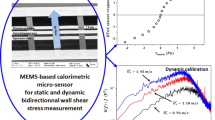Abstract
To investigate the role of a single shield on steady temperature measurement using thermocouples in hot air flow, a methodology for solving convection, conduction, and radiation in one single model is provided. In order to compare with the experimental results, a cylindrical computational domain is established, which is the same size with the hot calibration wind-tunnel. In the computational domain, two kinds of thermocouples, the bare-bead and the single-shielded thermocouples, are simulated respectively. Surface temperature distribution and the temperature measurement bias of the two typical thermocouples are compared. The simulation results indicate that: 1) The existence of the shield reduces bead surface heat flux and changes the direction of wires inner heat conduction in a colder surrounding; 2) The existence of the shield reduces the temperature measurement bias both by improving bead surface temperature and by reducing surface temperature gradient; 3) The shield effectively reduces the effect of the ambient temperature on the temperature measurement bias; 4) The shield effectively reduces the influence of airflow velocity on the temperature measurement bias.
Similar content being viewed by others
References
Park R M.: Manual on the use of thermocouples in temperature measurement. American Society for Testing & Materials, Philadelphia, (1993).
Rizika, J. W., and Rohsenow, W. M.: Thermocouple thermal error, Industrial & Engineering Chemistry, 44(5), pp. 1168–1171, (1952).
Bontrager, P. J.: Development of thermocouple-type total temperature probes in the hypersonic flow regime, Arnold Engineering Development Center, Tennessee, pp.20–23, (1969).
Bradley, D., and Matthews, K.: Measurement of high gas temperatures with fine wire thermocouples, Journal of Mechanical Engineering Science, 10(4), pp. 299–305, (1968).
Blevins, L. G., and Pitts, W. M.: Modeling of bare and aspirated thermocouples in compartment fires, Fire safety journal, 33(4), pp. 239–259, (1999).
Pitts, W. M., Braun, E., Peacock, R. D., Mitler, H. E., Johnsson, E. L., Reneke, P. A., and Blevins, L. G.: Temperature uncertainties for bare-bead and aspirated thermocouple measurements in fire environments, Thermal Measurements: The Foundation of Fire Standards, Tsukuba, (2003).
Luo, M.: Effects of radiation on temperature measurement in a fire environment, Journal of Fire Sciences, 15(6), pp. 443–461, (1997).
Brohez, S., Delvosalle, C., and Marlair, G.: “A two-thermocouples probe for radiation corrections of measured temperatures in compartment fires,” Fire Safety Journal, 39(5), pp. 399–411, (2004).
Kim, S. C., and Hamins, A.: “On the Temperature Measurement Bias and Time Response of an Aspirated Thermocouple in Fire Environment,” Journal of Fire Sciences, 26(6), pp. 509–529, (2008).
Etemad, S.: “Thermal Simulations of Thermocouple Tips in Hot Jets,” Journal of Thermal Science and Engineering Applications, 6(4), p. 041008, (2014).
Inc, F.: GAMBIT Modeling Guide Fluent Inc, (2003).
Rohsenow, W. M., Hartnett, J. P., and Cho, Y. I.: Handbook of heat transfer, McGraw-Hill New York, (1998).
Acknowledgments
This study was supported by the National Natural Science Foundation of China (Grant No. 51776011).
Author information
Authors and Affiliations
Corresponding author
Additional information
This study was supported by the National Natural Science Foundation of China (Grant No. 51776011).
Rights and permissions
About this article
Cite this article
Ma, H., Shi, L. & Tian, Y. Role of a single shield in thermocouple measurements in hot air flow. J. Therm. Sci. 26, 523–532 (2017). https://doi.org/10.1007/s11630-017-0969-9
Received:
Published:
Issue Date:
DOI: https://doi.org/10.1007/s11630-017-0969-9




